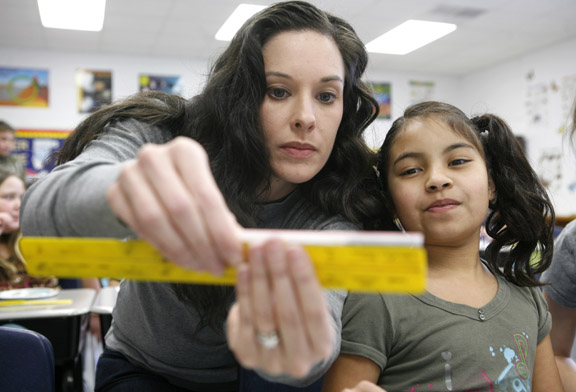
Deborah Cathcart works with 5th-grade students Michael Carter, left, Wyatt Gray, center, Davion Radford, right, and Kolby Morris, far right, on identifying and correcting problem areas with their on-demand writing pieces at Lacy Elementary School (Christian County) Feb. 2, 2011. Lacy Elementary is a 2010 Distinguished Title I School. Photo by Amy Wallot
By Matthew Tungate
matthew.tungate@education.ky.gov
Resource teacher Neeley Conrad will tell you that Lacy Elementary School (Christian County) is the kind of place where a 5th-grader stands up to a bully by declaring his intelligence. She’ll tell you about a student making the academic team and becoming a leader in spite of the gang influence around him. She will tell you about a boy who stands to lead the devotional at church and prays for the success of his school.
“The pride our students have in themselves is the most important thing at Lacy (Elementary),” she will say.
Conrad, who is in her second year at Lacy Elementary, also will tell you why the students feel that way without even trying.
She will tell you about a 5th grader from a family with limited financial means walking the halls with pride because his principal took him to get a haircut. Or that the principal will drive to a student’s home if the child has missed the bus and has no other way to get to school. Before school even starts each year, teachers visit the home of every Lacy Elementary student.
Sutton Elementary School (Owensboro Independent) mathematics intervention teacher Johnsie Tucker said teachers there feel the same way as their counterparts at Lacy Elementary.
“We realize that more than 360 children are ours, not just the 24 in our rooms,” said Tucker, in her 40th year of teaching, 13 of them at the school.
The two schools have a lot of educational things in common, including high expectations, data-driven instruction, professional learning communities and regular monitoring of student improvement. But they also have something else – something that can’t be measured. Teachers at both schools take the success of each child personally. That may be one reason they are Kentucky’s honorees as 2010 National Title I Distinguished Schools.
Since 1996, the National Title I Distinguished School Program has honored schools across the country for their innovation in helping large populations of low-income students achieve high educational standards. Selected from each state by members of the National Title I Association, these schools represent examples of superior Title I programs in one of two categories:
- closing the achievement gap between student groups
- exceptional student performance for two or more consecutive years
David Millanti, program consultant and federal program liaison for the Kentucky Department of Education, recommended Lacy and Sutton elementaries after reviewing data from recent Kentucky Core Content Tests (KCCT) and No Child Left Behind results.
Millanti said Lacy Elementary closed achievement gaps among all its student populations, and Sutton Elementary had some of best overall scores on the KCCT.
Lacy students benefit from data-driven instruction
Second-year curriculum specialist Leigh Ann Stewart said that when Lacy Elementary students are asked, “Why do you come to school,” they simply reply, “To learn.”
Conrad said their students are motivated by a desire to do well.
“Before testing, in the spring, our principal meets with each student and asks them how they were going to do on the KCCT test and what they are going to do to make sure they achieve the goal,” she said. “The students don’t respond by saying that they are going to do well.”
For example, a student may say, based on their own progress throughout the year, that they will get distinguished in mathematics, proficient in reading and distinguished in social studies, Conrad said. When asked how they know, they will reflect back to the learning checks they have taken this year.
“Not only do we use our data as teachers, our students use their data,” she said.
Conrad has a data board in her classroom that lists each student by a private number. The numbers are on sticky notes positioned under Novice, Apprentice, Proficient and Distinguished, so students can see what they scored on the last test. On each sticky note is an A, P or D, but never an N. These letters represent their goal – how they project they will do on the KCCT test, she said.
“By the way, no students chose A for a goal,” Conrad said. “Some of my 5th graders chose D, and I believe that they will do it.”
Sherry Covington, who has taught kindergarten for 21 years at Lacy Elementary, said teachers continually look at data to find gaps.
“We actually have data boards in 3rd through 5th grade that track all those students in all subject areas,” she said. “Our teachers know exactly where their students are academically, who is struggling and what content they are struggling with.”
The school implemented a response to intervention program last year for all grade levels in reading and mathematics, Covington said. Teachers use research-based intervention strategies and work on skills that these students are lacking, she said.
Second-year Principal Chris Bentzel said the school with 326 students – 68 percent of whom are on free or reduced-price lunch – had been the smallest in Christian County until this year.
“Because of our recent success, I believe we are slowly making a name for ourself, and people are starting to want to send their kids to Lacy,” he said. “It’s great for our school and for the community.”
Sutton focuses on needs of individual student
First-year Principal Danna Johnson said teachers and staff at Sutton Elementary work hard to meet the individual needs of the 375 students in grades K-4 – 47 percent of whom are eligible for free or reduced-price meals.

Science teacher Jaime Quattrocchi helps 4th-grade student Erin Lincoln measure the amount of chocolate chips she collected from a cookie at Sutton Elementary School (Owensboro Independent) Feb. 4, 2011. As part of their lesson about rocks, minerals and the Earth’s resources, the students did a “Mining for Minerals” lab where they “mined” chocolate chips from cookies. Sutton Elementary is a 2010 Distinguished Title I School. Photo by Amy Wallot
She said the school’s reading and mathematics intervention specialists, both of whom are paid for with grants, are integral to helping struggling students, who are monitored for progress every week.
“We are all here to help students be successful,” Johnson said. “All team members work hard to ensure that our students are successful.”
Tucker, the mathematics intervention specialist, said being able to work with small groups gives her time to concentrate on the needs of struggling children.
“Classroom teachers do not have the time to take individual students to fill in the gaps in their learning,” she said. “These children often get left behind or learn to cover up their lack of knowledge. The fear of being ‘discovered’ is gone because they learn making mistakes is okay, and the extra help is welcomed. They gain self-confidence, and it carries over into their other subjects.”
First-year curriculum facilitator Jamie Self, in her sixth year at Sutton Elementary, said all students are monitored in mathematics and reading, and 2nd, 3rd and 4th graders are tested in language arts as well.
Those students who are below grade level receive more intensive instruction, she said.
Tucker said that each week each classroom teacher completes a “Just In Time” sheet, noting any concerns about health, home, homework, grades and attitude.
“This sheet is addressed at a meeting on Monday morning with our support team, and follow-up is done,” she said. “Feedback is done at the weekly grade-level meetings with the principal and curriculum coordinator.”
Self said all the attention and intervention show how much the staff at Sutton Elementary cares about each individual student.
“Sutton has students, parents and a staff that are willing to do whatever it takes for each student to be successful lifelong learners,” she said.
MORE INFO…
Chris Bentzel, christopher.bentzel@christian.kyschools.us, (270) 887-7250
Danna Johnson, danna.johnson@owensboro.kyschools.us, (270) 686-1140
David Millanti, david.millanti@education.ky.gov, (502) 564-3791






















Leave A Comment